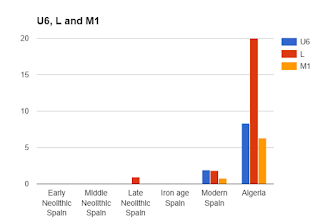Click HERE for a PDF version that is easier to read.***
I've scratched off a big chunk of Europe from my list of possible homelands for K1 and K1a because the evidence proves a large chunk of K1 in Europe arrived from Anatolia in the Neolithic(See the map below). By and large K1a in (Western?) Europe falls under a handful of subclades dated to the early Neolithic: K1a4a1(9ky), K1a2a(8ky), K1a3a(10ky), K1a1b1(8ky). All of those clades have been found in Neolithic farmers from Spain and Britain but not in any Mesolithic European foragers.
Click HERE for a PDF version that is easier to read.***
Here are phylogenetic trees I made for K1. The trees include age estimates I get for K1 clades using Soares 2009's age estimator.
K1a tree. *Blank boxes are for rare K1a clades. I only show the name of popular K1a clades.
Click HERE for a PDF version that is easier to read.***

Other K1 tree.
Click HERE for a PDF version that is easier to read.***
In the Middle East, and possibly some parts of Europe, K1a has few links to K1a in (Western?) Europe. The only K1a clade common in both Europe and the Middle East is K1a4 (13ky). This means most European (ultimately Anatolian) and Middle Eastern K1a clades went their separate ways way back in the Early Mesolithic.
mHG U5b1 (19ky) shows this same pattern. Most U5b1 clades in Spain and Eastern Europe went their separate ways back in the Mesolithic/Late Paleolithic. Ancient mtDNA confirms U5b1 (19ky) clades had already expanded and gained popularity by the Mesolithic. The same may turn out to be true for K1a (17ky).
Mesolithic K1a didn't have the same geographic extent it has today. I think K1 and K1a were expanding, diversifying into new subclades, only within some populations of the 'East Mediterranean.' Anatolia Neolithic's mysterious 'UHG' ancestor was definitely one of those populations.
There's actually already documentation of K1 in the Mesolithic 'East Mediterranean'. The first two mtDNA samples from Mesolithic Greece belong to the same rare or extinct K1c* clade (See here) and 26% (11 out of 42) of mtDNA samples from Mesolithic Serbia/Romania belong to now rare or extinct forms of K1(K1*=6, K1c*=3, K1a*=1, K1f*=1).
Watch when someone sequences DNA from Mesolithic Anatolia. I won't be surprised at all if the results are a WHG-like population with 50% mHG K1 that fits well as Anatolia Neolithic's 'UHG' ancestor.
K1a tree. *Blank boxes are for rare K1a clades. I only show the name of popular K1a clades.
Click HERE for a PDF version that is easier to read.***

Other K1 tree.
Click HERE for a PDF version that is easier to read.***
In the Middle East, and possibly some parts of Europe, K1a has few links to K1a in (Western?) Europe. The only K1a clade common in both Europe and the Middle East is K1a4 (13ky). This means most European (ultimately Anatolian) and Middle Eastern K1a clades went their separate ways way back in the Early Mesolithic.
mHG U5b1 (19ky) shows this same pattern. Most U5b1 clades in Spain and Eastern Europe went their separate ways back in the Mesolithic/Late Paleolithic. Ancient mtDNA confirms U5b1 (19ky) clades had already expanded and gained popularity by the Mesolithic. The same may turn out to be true for K1a (17ky).
Mesolithic K1a didn't have the same geographic extent it has today. I think K1 and K1a were expanding, diversifying into new subclades, only within some populations of the 'East Mediterranean.' Anatolia Neolithic's mysterious 'UHG' ancestor was definitely one of those populations.
There's actually already documentation of K1 in the Mesolithic 'East Mediterranean'. The first two mtDNA samples from Mesolithic Greece belong to the same rare or extinct K1c* clade (See here) and 26% (11 out of 42) of mtDNA samples from Mesolithic Serbia/Romania belong to now rare or extinct forms of K1(K1*=6, K1c*=3, K1a*=1, K1f*=1).
Watch when someone sequences DNA from Mesolithic Anatolia. I won't be surprised at all if the results are a WHG-like population with 50% mHG K1 that fits well as Anatolia Neolithic's 'UHG' ancestor.























